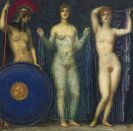
Ludwig von Hofmann
1861 Darmstadt
1945 Pillnitz
The German painter and graphic artist Ludwig von Hofmann was born in Darmstadt in 1861. In 1883 he began to study at the Dresden Academy of Fine Arts, in 1886 he transferred to the class of Ferdinand Keller at the academy in Karlsruhe. In 1889 Ludwig von Hofmann went to Paris and attended the Académie Julian. During the time in Paris the works by the symbolist artist Puvis de Chavanne and the impressionist painter Paul-Albert Besnard left particular impression on him.
As of 1890 Ludwig von Hofmann was active as artist in Berlin. He was an active part of the Berlin art scene and had thorough interest in latest tendencies in art. In 1892 Ludwig von Hofmann was one of the founding members of the artist group “Die XI“. Around 1892 Ludwig von Hofmann saw paintings by Hans von Marées for the first time and was deeply impressed by their idealism and Arcadian atmosphere. As of 1895 he made illustrations for the magazine Pan. In 1898 Ludwig von Hofmann became member of the Berlin Secession. Additionally, he traveled to Italy on many occasions between 1894 and 1900, spending a longer period of time in Rome.
In 1903 Ludwig von Hofmann was appointed professor at the Weimar Grand Ducal Art School. He was in close contact with the artistic and literary avant-garde around Harry Graf Kessler and Henry van de Velde, he also became a key member of the movement “Neues Weimar“. In Weimar Ludwig von Hofmann met the writer Gerhart Hauptmann with whom he went on a journey to Greece in 1907. The same year he executed a mural for the lobby of the Neues Theater in Weimar. In 1909 he made a mural for the assembly hall at Jena University. In 1916 Ludwig von Hofmann left Weimar and began teaching as head of the Class for Monumental Painting at the Dresden Academy, a post he held until 1931. In 1919 he received the commission for the decoration of the reading room at the German National Library in Leipzig. Ludwig von Hofmann‘s works adopt inspiration from various tendencies of contemporary art such as Historism, Symbolism and Art Nouveau. Light-flooded Arcadian landscapes with mostly idealized male and female nudes in harmony with nature are his most characteristic motifs. Apart from Ludwig von Hofmann‘s oeuvre of oil paintings, he also created a vast graphic oeuvre that comprises many illustrations and portfolios.
Ludwig von Hofmann died in Pillnitz near Dresden 1945.

Would you like to sell a work by Ludwig von Hofmann?
Infos for sellerART MARKET:

Urteil des Paris
Oil on panel, 1922
Estimated price 120.000
More offers >






